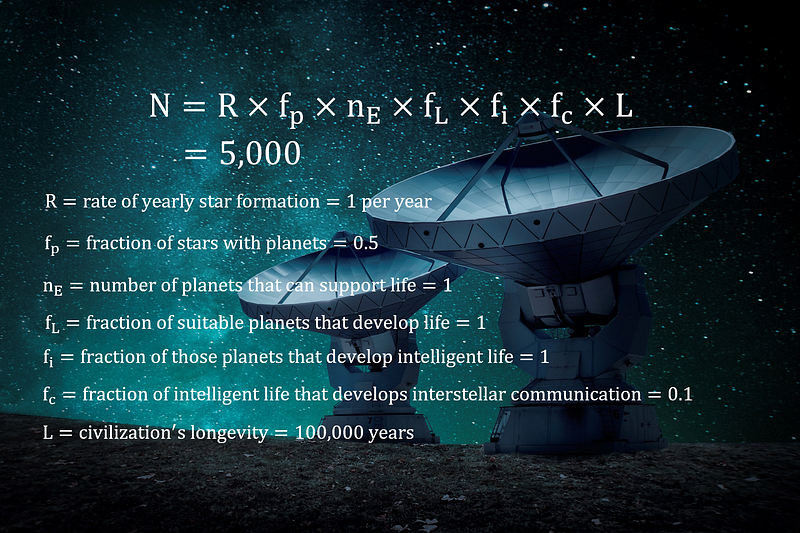# Estimating Advanced Extraterrestrial Civilizations in Our Galaxy
Written on
Chapter 1: The Search for Extraterrestrial Life
How many advanced extraterrestrial civilizations might exist in our galaxy? This intriguing question has prompted numerous astronomers to seek an answer. The debate over whether intelligent life is isolated in the universe remains one of science's most compelling mysteries. A pivotal tool for exploring this question is the Drake Equation, introduced by Frank Drake, which is often hailed as the second most recognized equation in science, following E=mc².

Frank Drake was the pioneering scientist who initiated the search for evidence of advanced extraterrestrial life. In 1960, he launched Project Ozma at the National Radio Astronomy Observatory, employing radio telescopes to monitor signals from two stars, Epsilon Eridani and Tau Ceti, located approximately 10.5 and 12 light-years from our Sun, respectively. Both stars were similar to our Sun and were thought to potentially host planets capable of sustaining life.
Remarkably, shortly after the project began, Drake detected what appeared to be an artificial electromagnetic signal. While astronomers can differentiate between natural cosmic phenomena and artificial signals, this initial discovery turned out to be a misinterpretation; it was merely interference from a classified military operation. Nonetheless, even without finding aliens, Project Ozma was crucial as it laid the groundwork for the Search for Extraterrestrial Intelligence (SETI).
Undeterred by this setback, Drake convened a conference in 1961 with leading scientists and engineers to discuss the potential for detecting genuine alien radio signals. During this event, he presented a straightforward formula aimed at estimating the number of technologically advanced extraterrestrial civilizations in our galaxy that might be sending signals to neighboring stars—this formula is now widely known as the Drake Equation.

The Drake Equation outlines several variables, where ( N ) represents the number of communicating extraterrestrial civilizations within our galaxy. By multiplying various factors, scientists can arrive at an estimation, as illustrated below:

Let’s attempt to apply this equation ourselves and see what we find. The equation comprises multiple unknowns, requiring certain assumptions for calculation. For this discussion, I will utilize my own estimates: current astronomical data suggests that approximately one star forms each year in our galaxy, and around half of those stars are expected to have planets. I will optimistically assume there is one planet per star capable of supporting life, based on the Earth's ability to host life.
Furthermore, I will posit that if a planet has the potential for life, then that life will inevitably emerge, so I will assign ( f_L ) a value of 1. Additionally, I will assume that intelligent life will eventually develop if life exists on a planet, assigning ( f_i ) a value of 1 as well. The final two parameters involve more uncertainty; I estimate that roughly 10% of intelligent species will develop technology for interstellar communication, and I will assume that such civilizations last, on average, for about 100,000 years before facing extinction.
By plugging these assumptions into the equation, I arrive at an estimate of 5,000 communicating extraterrestrial civilizations in our galaxy today. I encourage readers to calculate ( N ) using their own assumptions and share their findings in the comments.

While 5,000 may seem like a hopeful estimate, I believe it is fairly plausible given astronomical discoveries. With an estimated 300 billion stars in our galaxy, the potential for life exists in numerous locations. Additionally, our Sun is not unique; if intelligent life could emerge in our solar system, why couldn’t it elsewhere?
The universe has had sufficient time for life to evolve in other regions. Current estimates suggest the universe is around 13.8 billion years old, which dwarfs the approximately 200,000 years of human existence. Should extraterrestrial civilizations exist, some may be millions or even billions of years old, potentially possessing the technology to colonize the galaxy. Yet, the absence of evidence raises an intriguing question: Where is everyone?
Chapter 2: Insights from Recent Research
The first video, "How Many Alien Civilizations Exist in Our Galaxy?" delves into the exploration of the existence of alien civilizations and the methodologies used in this search.
The second video, "New Study Suggests 36 Alien Civilizations In The Milky Way, But..." offers an insightful analysis on the implications of recent studies regarding alien life.
If you enjoyed this article, you might find these topics interesting:
- The Evolution of Nanotechnology: A Historical Overview
- Historical Instances of Alleged Contact with Aliens
- Scientific Approaches to Making Contact with Extraterrestrial Life
Citations:
Webb, Stephen. If the Universe Is Teeming with Aliens . Where Is Everybody? Seventy-Five Solutions to the Fermi Paradox and the Problem of Extraterrestrial Life. Springer-Verlag, 2015.